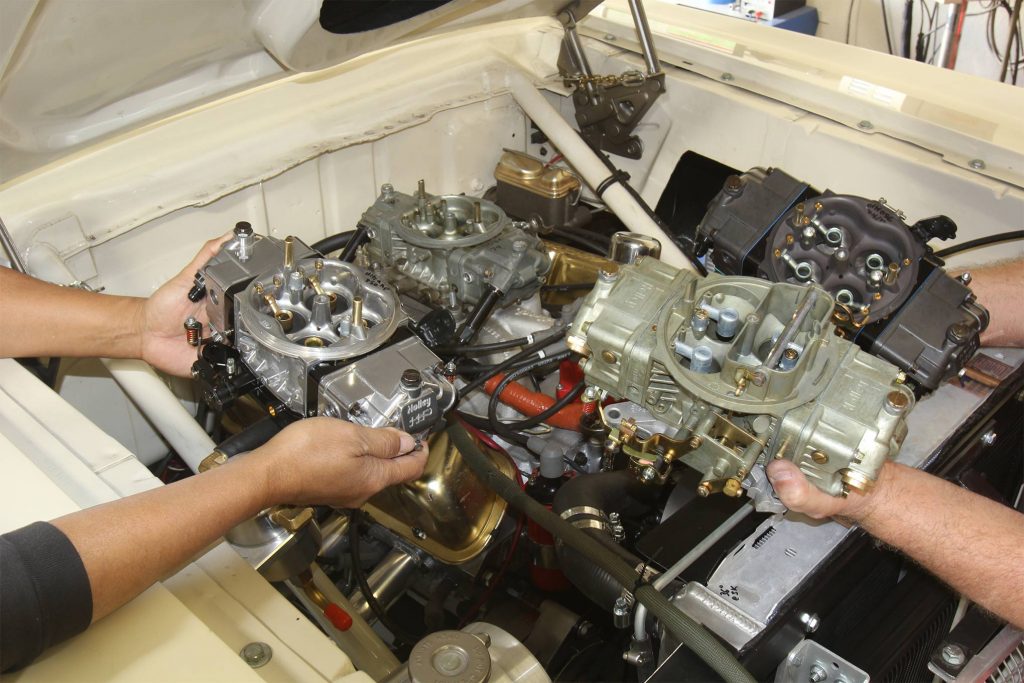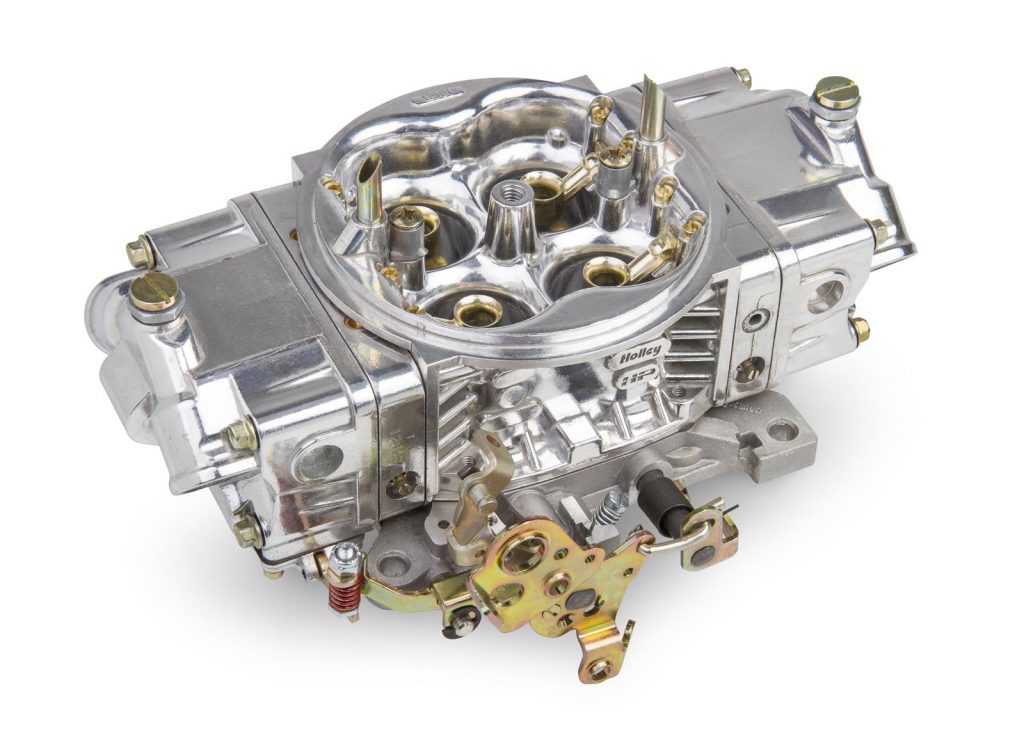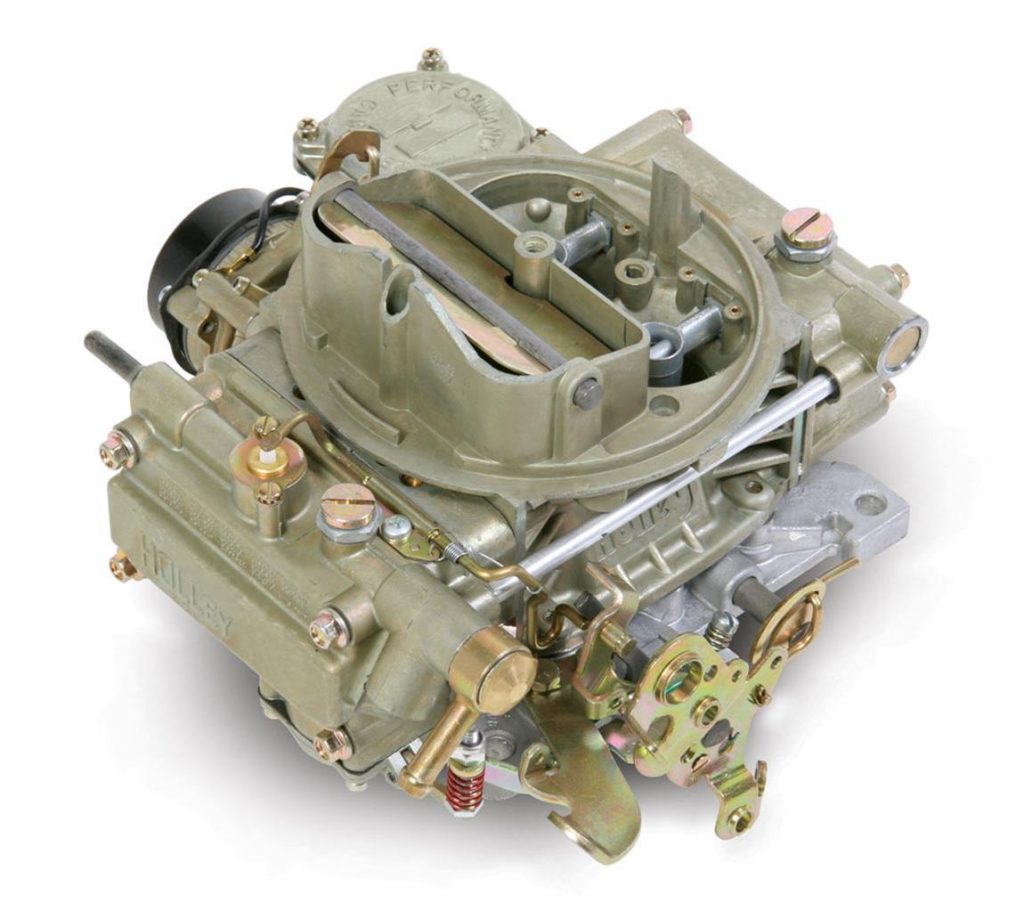
Once described as the small block Chevy of fuel delivery, the Holley 3310 carburetor (4150 and 4160 models) landed at #1 on our list of most important aftermarket parts of all time.
Introduced in 1965, it’s still the go-to carburetor for anyone building a performance engine.
It’s a question our partners at Summit Racing still hear, and it’s a common topic in forums and within Google search results, where customers seek out the differences between the Holley 4150 and 4160.
It’s important to note that 4150 and 4160 denote a carburetor style or design, and many of Holley’s carburetors feature one of these two setups — even if the 4150/4160 moniker doesn’t appear in the product name.
The question is: What’s the difference between those 4150 and 4160 versions?
Holley 4150 Overview

The 4150 carburetor was first introduced for the 1957-58 Ford Thunderbird. Labeled by Holley as its first true performance carburetor, this original 4150 carburetor introduced the famous Holley modular four-barrel design we know today.
Originally rated at 400 cfm, this carburetor was updated to flow 780 cfm and reissued as original equipment for the 425-horsepower Z16 Chevelle.
The 4150 carburetor used on the Z16 Chevelle featured vacuum secondaries and center-hung “cathedral” float bowls. In 1966, it was dropped as an OE carburetor and introduced into the aftermarket.
Often referred to simply as the “double pumper,” the 4150 and 4150-style carburetors fuel-feed inlets and a second full metering block on the secondary side, giving it dual accelerator pumps. This full metering block makes the 4150 arguably the most tuneable carburetor on the market, since it has power valves and accelerator pumps on both sides.
Typically equipped with mechanical secondaries (though not always), 4150-style carburetors will be ideally suited to a lighter-weight vehicle, manual transmissions with a lot of gear, and the ability to create higher rpm.
Holley 4160 Overview

The Holley 4160 carburetor was introduced as an updated version of the 4150 in the 1970s.
The most noticeable difference in the 4160 is the thin secondary metering plate, which is used in place of the secondary metering block. While this makes the 4160 less tuneable than its 4150 forefather, it necessitates only a single fuel line (a transfer tube brings fuel from the primary side to the secondary side) which makes installation simpler.
The 4160 comes with vacuum secondaries and is great for street applications. The vacuum secondaries make it great for heavier-weight vehicles, low- and mid-rpm performance, and automatic transmissions.
This video covers the main differences between the 4150 and 4160:
Popular Holley 4150 Styles
- Holley 4150 Double Pumper Carburetor — ideal for hot street cars and race applications and available in CFM ratings up to 850.
- Holley 4150 Classic Carburetor — great for stock to mildly modified vehicles, these carburetors stray from many other 4150 styles by offering a vacuum secondary setup.
- Holley Aluminum Street HP Carburetor — available in both vacuum and mechanical secondary styles, these carbs weigh up to 40 percent less than comparable designs and are good for street and light competition use.
- Holley Ultra Double Pumper Carburetor — this version incorporates an enhanced fuel curve and additional performance features like 4-corner idle, clear fuel level sight plugs, four vacuum ports, and more.
- Holley Model 4150 Aluminum Double Pumper Carburetor — these carbs weigh 38 percent less and are optimized for street and strip calibration.
- Holley 4150 Classic HP Carburetor — available in CFM ratings up to 1,000, these double pumper carbs feature high-flow metering blocks and are great for all forms of motorsports.
- Holley 4150 HP Supercharger Carburetor — designed for use with superchargers, Holley added screw-in air bleeds, a notched float, jet extensions to prevent fuel starvation, and more.
- Holley 4150 Supercharger Carburetor — designed for use with superchargers, this carburetor offers many of the same features as the HP version above, but with a slightly more budget-friendly price.
- Holley 4150 Street HP Carburetor — great for street/strip use, these carbs combine excellent throttle response, drivability, and performance.
- Holley 4150 Competition Double Pumper Carburetor — designed for use on all-out race vehicles that are lightweight with a manual transmission or an automatic with high-stall converter.
Popular Holley 4160 Styles
- Holley 4160 Aluminum Street Carburetor — a great bolt-on for a wide variety of street-oriented vehicles and available in 600 and 750 cfm options.
- Holley 4160 Non-Adjustable Float Carburetor — equipped with Tru-Set needle and seats, this design eliminates the need for external adjustments and offers a true “bolt-on and go” design.
- Holley 4160 Adjustable Float Carburetor — made for stock or mildly modified engines, this setup is easier to tune than other styles of carburetors and offers more adjustability than its counterpart above.

There was no “Y” block option on the ’58 Thunderbirds. The only 2 available engines were the 352 “FE” and the 430 “MEL”.
I HAVE A 660 STREET ADVENGER HOLLY O BOUGHT NEW AT ADVANCE AUTO PARTS CHEBOYGAN MICHIGAN ON SET SCREW HOW MANY TURNS OUT AFTER ALL THEY WAY TIGHT SHOULD IT BE I WAS TOLD 1 AND HALF IS THIS CLOSE TO RITE OR RIGHT ???
After gently seating one at a time (with engine at operating temperature if possible) turn out slowly until it runs good, no more and she should be good. Repeat for the others.
THANKS FOR SHARING ALLL THE GREAT INFO REALY LOVE ON ALL CYLINDERS SITE LEARN ALOTE LIKE ON DISTRIBUTER CAP I READ EARLIER TOO
I have identified the carb on my stock 300hp 327 as a 4160 (1850-1, date code 2188). Single fuel feed but it has a secondary metering block, not plate. Would the carb be set up like this because it has a 250 wet shot NOS? Trying to figure out what I need for basic rebuild.
nope, 4160 wasnt out till the 70’s
4160 (3310-?) have dual fuel inlets. 3310-1 had dual fuel metering blocks as well. Holley then switched tot he metering plate for the 4160 (3310-2 and up). I believe this is correct. Kinda contradicts the video.
That’s because 3310 and 3310-1 are 4150 and 3310-2 are 4160 carbs. No contradiction.
Here is a good reference:
http://www.classiccoachupdate.com/files/HOLLEY_CARB_INFO.htm
Help with my 4150 HP’s? 850dp’s on my bbc with Weiand tunnel ram. I believe they’re the “annular discharge style (no choke horn), anyway, my primary discharge squirter on one is a weak, broken spittle even when I squeeze the accelerator pump manually? I have the float/fuel level about halfway in the sight glass, the 4-corners are out 1 1/2 turns, when it fires I can’t seem to get an idle? If I “rev” the throttle it seems like I’m trying to support the motor with just the front carb and if I can get her to stumble, rev 1-2 times and die, do this 4-5 times my garage isn’t choking you out like I’m way to rich? I don’t see a booster seeping or an atmospheric vent overflowing? I know this is a lot of information but I’ve been building this car tribute to father (both of us retired disabled veterans, he passed 5 years ago, I’ve had an aneurysm from a duty related TBI) and I am not a Holley expert and I need help! The carbs are new, purchased a year apart and finally installed and trying to start when the newer was about 1 month old. Is there something I should do to baseline them about the same?
The Holley 3367 carburetor on the 1966 Corvette was a 4160 correct? So, it came out before the 70s…